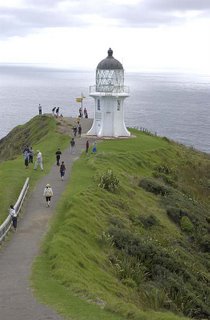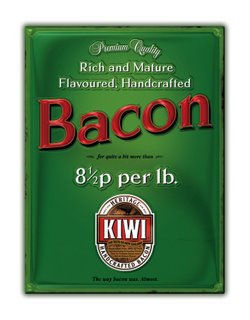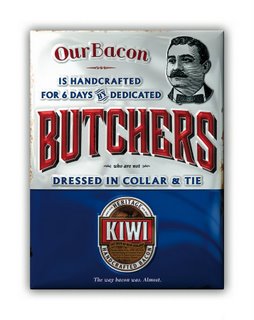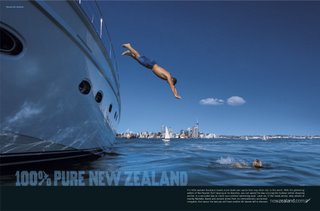In adagetoday there's an interesting article about how the newest US Army TV commercial is in Arabic to specifically target its target audience. The media buy was for Arabic TV networks too. And all of this was done by McCann-Erickson out of the most American of cities, NYC.
Wednesday, June 28, 2006
Online: Royksopp- Remind Me
Leave it to the Europeans to come up with cool animation in music videos and commercials that's backed up by a solid concept. These remind me of the TBWA/ Paris commercials for HIV/AIDS prevention.
By David Wen 0 comments
Labels: online
Sunday, June 25, 2006
Ads: funny advertising
I don't know if y'all have seen this before, but I think its hilarious. If you don't get it, read it out loud and you will.
By Anonymous 0 comments
Labels: ads
Saturday, June 24, 2006
Industry: People are not who they appear to be
There is a very poignant and realistic post about human nature on Mack Simpson's Adverb.
This article "serves as a warning to anyone who works in our industry that, literally, anything can and will happen-- so plan accordingly."
edit Mack is a Texas Exe working at Dieste Harmel & Partners and one of their TV spots was shortlisted at Cannes this year!
By David Wen 0 comments
Labels: industry
Thursday, June 22, 2006
Marketing: Nike is at it again

On the heels of Ashley's Coupe Du Monde post, I decided to talk some more about soccer (football).
Since when did Nike become the cause-related marketing/PR leader?
First they create the smart and catchy Go Yellow/Live Strong with yellow wristbands (with Lance Armstrong) and now they have a help fight poverty with soccer campaign.
I received a ninemillion.org newsletter in my inbox this morning. Take a look here
I wonder how much Nike Inc. has donated? If Phil Knight can donate $50 million to upgrade the Univ. of Oregon's football locker room, I'm sure he has some more spare change lying around.
Also, what's the last cause-related marketing initiative that you've heard of from adidas-reebok (they're merged now), puma, or converse (owned by nike)?
By David Wen 2 comments
Labels: marketing
Tuesday, June 20, 2006
adidas v. nike ... the final showdown


These are the famous adidas "sistine chapel ads" painted in a German train station ceiling. from Advertising for peanuts.
vs. from Hidden Persuader.
from Hidden Persuader.
The 2006 World Cup is finally getting exciting and with the nearly worldwide exposure, it isn't only a war between the 32 participating teams; it is an epic battle of logos and sales. Sportswear giants Adidas and Nike are vying like mad to get their brands in front of the predicted 32 billion TV viewers, and with Adidas's position as the World Cup official sponsor, Nike may have reasons to start shaking in their footballer boots.
Adidas has so far spent about 225 million on this World Cup endeavor, in a smart marketing move they're milking this sponsorship gig for all that it is worth. With their recent Reebock conquest, the bragging rights as the global leader in soccer footwear and the new World Cup matchball, Adidas is running firm.
But …
With all official world-cup media covered by Adidas's three stripes, Nike has taken an unusual guerilla route and pulled out all the stops with a new campaign, Joga Bonito [play beautiful in Portuguese]. Nike has taken to sponsoring Joga 3 games in Europe, a series of 3 on 3 matches for under-20 players. They have even teamed up with Google to create joga.com, a myspace-esque site where soccer players can socialize and plan small matches. This football movement, as Nike would like you to see it, features the likes of Eric Cantona and Brazilian football star Ronaldinho. The spots focus on the presumably forgotten values of the game, skill, honor, joy, heart and team spirit; but wait, is this the same go-for-broke, blood-sweat-and-tears Nike that America knows and loves? Either way, Nike is making an even bigger name for themselves in the soccer world, ironically with the younger, counter-culture generations of South America and Europe.
So who knows who will win the world cup this year, definitely not the US and my bet is probably somewhere south of the Equator, but the 'marketing cup' is what we ad-oholics are probably concerned with and in the end we all know it comes down to profit profit profit. We'll have to wait and see where the billions of dollars in expected postmatch sales fall.
** Come out and watch the Holland and Argentina match on wednesday. I'll be at Fado on 4th, so come cheer on your favorite brand [Holland - Nike / Argentina - Adidas]
By Anonymous 2 comments
Labels: marketing
The 2006 Cannes Advertising Festival
Leo Burnett Hungary has been shortlisting the top fifty commercials that they think are going to win at Cannes for several years now.
There's more Cannes news and ads at Adweek's coverage and Adage's coverage
edit There's also an amusing Cannes insider newsletter to peruse. It's quite cheeky and it comes from the land of bollocks and Beckham.
And adcritic has all the TV ads for view. for free.
By David Wen 0 comments
Labels: award
Thursday, June 08, 2006
Interview with Mario McMillan

I first heard about The Department of Doing, based in Auckland, New Zealand, from the NY Times advertising e-newsletter. So, being the naturally curious person I am, I contacted them to ask about their stupendous name. To my surprise, the Creative Director, Mario McMilan, contacted me back.
Mario started out in the ad business as a suit. When the medication finally became too expensive and increasingly ineffective his only option was to join the creative department. Since then he has created campaigns for Alfa Romeo, Pepsi Cola, Pizza Hut and all manner of other international brands. He has worked for Publicis, BBDO and Ogilvy & Mather; in London (for 9 years), in Dubai (for 4) and has lived and worked in New Zealand since 1997. As well as being an award-winning copywriter and creative director, Mario’s passion for motorsport saw him leave the ad business for two years in Dubai, becoming a professional race instructor and competitor.
Mario now describes The Department of Doing as a ‘spiritual home’ without the excesses, egos and endless meetings of big agency life, so that he can, simply, get things done.
I read a quote from the director of The Department of Doing, Richard Hollingum, who said, "We have a plan for world domination. New Zealanders get things done. It’s probably a lot to do with the fact that everyone has come here from somewhere else, whether it’s just yesterday or a few generations ago.” Your communication agency name is one of the best ones I've ever seen. Did the name "Department of Doing" come out of this thinking?
I wouldn’t say the name arose directly from New Zealanders being a pragmatic, down-to-earth bunch – the progeny of pioneers – but it certainly means we are very much at home here. The name came about because of a sense of intense frustration. A lot of us at The Department of Doing are ex-agency and the reason we’ve been drawn here is because we saw too many fine ideas never happen when we were sitting inside major ad agencies.
As a creative person, I find this infuriating. I love creating things and that means seeing them happen.
What separates the Department of Doing from an advertising agency?
Superficially, we do many of the same things. We create press ads and TV ads and billboards, that sort of thing. And we do a lot of other stuff too. The real difference, I guess, is in our attitude and approach, and it boils down to this: we bring ideas to life; we make them happen. Sometimes they’re our own ideas, sometimes other people’s.
At The Department, we have a lot of sympathy for the notion that the conventional agency model is broken. And before I bring the wrath of Madison Avenue upon my head, I have to acknowledge that many agencies do some things supremely well. There are fantastic, world-changing ads coming out of Crispin Porter + Bogusky, Mother and longer-established agencies like Bartle Bogle Hegarty. Even the big groups are still pumping out great ads and great ideas. Right here in New Zealand, Saatchi & Saatchi, BBDO, DDB, Publicis Mojo and others are producing world-class work that will make you laugh, cry; fall in love with a brand.
But I bet any creative team you care to mention has a bottom drawer full of great ideas that never happened. And I’m not just talking about clients who rejected them. Just as often it’s because the agency is designed to produce certain things. And when your idea isn’t one of those things, you hit a problem. Business as usual won’t get the job done.
Let me just follow a train of thought here and - I apologise - it involves another well-known American educational institution: Stanford. Professors Jeffrey Pfeffer and Robert I Sutton there have published some great work on what they describe as ‘The Knowing-Doing Gap.’ We first read some abstracts a few years ago and then bought their books. And we simply couldn’t agree with them more. Encapsulating academic work in a nutshell can be a dangerous game but, hey, let’s go there. Essentially, they point out that organizations today are information-rich. They have more knowledge than ever before, greater ability to process it and there is a notion – very fashionable in ad agency circles – that success in the modern world is about the power of ideas. I mean, how often have you heard about Catching The Knowledge Wave or The Knowledge Economy or agencies describing themselves as Ideas Companies? Our view and, it would seem, the view of Pfeffer and Sutton is that generating loads of ideas that go nowhere is worse than useless. It employs resources in redundant ventures, it drains an organisation’s morale and it means you are going to get your arse kicked by competitors that actually make things happen whiled you sit pondering your next move.
There seems to be a gradual realization afoot that congratulating yourself on how great your ideas are and what a stupendous intellect you have is a path to failure. That what is missing is a focus on making those ideas happen. Agencies are realizing it too, and we’ve been working with two of the big international groups on changing their focus from being rather academic idea factories into genuine Doing organizations. It is not an easy change but it can be done.
A lot of agencies have corporate manifestos. Can you talk about The Directives of Doing?
For a start, I guess you have to appreciate a certain ironic sense of humour to ‘get’ them. The Directives are quite deliberately written with touch of flippancy. And that’s because they are so very important to us. They are immutable principles but we don’t want to be aggressive or arrogant or insensitive about it. We’ve seen enough of that in the agency world and we have no desire to promulgate it ourselves. But, as it says in Directive 7.a, we do refuse to work with people we neither respect nor like, or who wear grey shoes.
I’ve heard countless corporate Missions and Visions and Values and they all say the same thing, and they all sound like a fraud. If you read our Directives of Doing and you don’t get them, or it doesn’t raise a smirk of appreciation, you should never, ever consider working with us: whether you’re a prospective employee or Richard Branson about to give us your business.
A common perception of New Zealand is The Lord of the Rings, rugby, yachting, kiwis and the Maori people. But New Zealand also has the 19th highest standard of living in the world. What is New Zealand really like?
I hate to tell you this, mate, because it’s going to make you feel jealous: New Zealand is the best place in the world.
Now, I’m allowed to say this because I chose this country: I didn’t have the good fortune to be born here. I’m originally a Scot, spent most of my early life in England, traveled the world like a Gypsy and lived in Dubai for years before coming here. Like quite a few Kiwis, I now have dual nationality as a Brit and a New Zealander. My UK passport means I can live and work anywhere in the European Union. As a Kiwi I can live in Australia if I want. Courtesy of a very old visa from my Gypsy years, I could even stay indefinitely in the USA.
I choose to live in New Zealand for a lot of reasons. It’s far from perfect, occasionally drives me mad, and some things suck. But it has so much going for it. First, there’s a lot of space, which I like. Useable space, too. Aussie has loads of space but frankly you’d never want to venture into a lot of it and it’s often just endless, featureless and quite dull. New Zealand is beautiful, green, often wild and incredibly varied. I’m a keen trout fisherman, so need I say more?
The other really big thing that keeps me here is the creative environment. You might be surprised to know that New Zealand comes second only to the UK when it comes to winning creative awards per capita. New Zealand creativity is now also getting recognized in movie-making, in fashion, in technology, in wine-making, you name it. And because we are such a small country – just 4 million souls – interaction between these things is unavoidable. You’ll be filming a TVC with crew who worked on Lord of the Rings, briefing animation to people who did Shrek, talk wardrobe with the designers from World fashion and, at the weekend, stop in the winery that just won Gold at the London International Wine Show, where you chat about the Rugby with the guy who made the stuff.
That small community feel and the friendliness of New Zealanders is something I’ve got used to and I wouldn’t want to swap it for anything. I still love going to big, bustling cities and doing business there – we work in Singapore, London, Sydney, Melbourne – but it’s so nice to come home.
New Zealand’s also pretty sophisticated: you don’t really miss out on the niceties of modern life but there’s still a bit of earthiness about living here. There are probably few places in the world where you can enjoy such sophistication in direct proximity to real wilderness.
And the weather’s not bad too. Just make sure you come during your winter – that’s our summer – unless you’re a ski bum.


You all have done work with a clothing company, operating across NZ and Australia, that involved corporate coaching and psychology. You all have even trademarked this process as 'Pitchcraft'. Can you talk about this unique work? Would a typical advertising agency have undertaken this task?
The company is called Deane Apparel and they’re the biggest corporate clothing company in Australasia. They are the most professional and best-resourced company in the game here, with fantastic systems, access to many designers and a back-up for customers that’s second to none. They came to us having lost about a dozen new business pitches in a row: nearly always against smaller outfits who positioned themselves as more ‘fashionable’, even when some of the accounts were for huge industrial companies where you’d think functionality, economy and back-up would be top criteria.
The people at Deane were great. They had the humility to understand that they weren’t presenting themselves as well as they could. And they knew they were a bit ‘down’ and, maybe, that was being sensed by clients.
We immediately saw parallels with the ad business. They were pitching for big accounts, they were fundamentally selling a creative product and there are all the usual issues of performing on the day, making a connection with people, chemistry etc. Their real-world abilities were excellent. But they had to wow the client at the pitch and they weren’t doing that.
We could help them do flash documents but, ultimately, they would have to connect with the client.
We began by getting them to talk and talk about their business, the clients, the job they do, their staff, everything.
What emerged was that their clients were viewing the purchase of apparel at a ‘brand’ level and Deane were talking at an operational level. We had to get the guys to be more brand-literate and to present what they were doing as part of a higher intellectual discipline. 90% rubbish, of course, but you’ve got to know your customer. And the key to all this was that Deane had never examined their own brand. We undertook a brand review of Deane. It was a bit of a catharsis because it forced them to look at and define things about themselves that they’d always ignored.
To cut a long story short, after the team there had been through all this they had a pretty deep understanding of the semantics and process of brand development. So when they next had a pitch they were operating at an entirely different level. They won it, and it was a big one: McDonald’s. They’ve since won five in a row and put on millions of dollars of revenue.
And the only bit of ‘creative work’ we’ve produced for them was a staff poster for McDonald’s new uniforms.
I really can’t give any detail about PitchCraft in general. Partly because it’s a proprietary secret but mostly because it will vary hugely depending on individual organisations’ needs.
Can you also talk about what The Dept. of Doing did for Chevrolet?
The Chevrolet job was one of those classics that goes straight into most agencies’ Too Hard basket.
General Motors had owned Korean car-maker Daewoo for a number of years. As a brand, Daewoo had a pretty poor rep everywhere except Korea. With the backing of research, GM decided to change the brand to Chevrolet, starting with Asia-Pacific.
Now that’s fine and dandy, until you look at the logistics. Fourteen countries and about seventeen languages. Scores of thousands of vehicles sitting around badged Daewoo. Hundreds of thousands of new brochures to be made. Every dealership to be re-branded. Guides required for everyone on how to rebadge, retouch and otherwise change everything they have in their possession from Daewoo to Chevrolet.
As well as line-producing all the new photography in New Zealand for the launch campaign, we produced a ‘bible’ and resource kit that showed every step required to effect the changeover.
I wouldn’t say it was the most sexily creative job we’ve ever done, but it sure was effective.
What is The Independent Network of agencies and how does that help The Department of Doing?
The Independent Network does exactly what it says on the tin. It’s a worldwide network of agencies that are completely independent of the big groups. It think there’s something like 80-odd agencies in 74 countries, and we can all use one another just like an international network.
For example, we have been used as an extra creative resource by agencies in Taiwan, Singapore and Kuala Lumpur when they’ve had a big campaign or pitch to crack out. Agencies pay one another on agreed rates, but its handy to know we could call on resources anywhere in the world. We also have a commitment to provide a certain amount of help, on request, without charging. And that’s really useful when you’re researching what might be going on in other markets.
Compared to the big groups, IN doesn’t provide legions of proprietary tools and research, but I’d say you still get 90% of the benefits.
In an interview I did with Ignacio Oreamuno, he talked about how business in other countries is very different than the US. What is doing business like in NZ compared to doing business in the US?
I wouldn’t say I have a lot of experience doing business in the United States, unless you count my days as a Busboy at Western Steer Family Restaurant in Myrtle Beach. But I have worked with many Americans internationally, ranging from clients to my Art Director.
I think there’s a very distinct American business culture, which you’d expect, and one of its important facets is its internationalism. The world’s most successful global brands are mostly American; Americans have proven themselves as global marketers like no other nation.
That’s not to say that there haven’t been occasional culture clashes or failures. But the smartest American businesses are great at seeking out local talent to make them successful.
The contrasts and similarities between national business – and specifically advertising – cultures are, I think, fascinating. I talked before about the extraordinary creative performance of New Zealand relative to our size. I wouldn’t be the first to ponder on why that should be. New Zealand inevitably first compares itself to Australia, and we significantly out-perform the Aussies creatively. Why should that be?
The popular culprit is corporate culture. Australia has four times our population. Businesses are bigger, there are more management tiers and, undoubtedly, doing business is more formal there.
In New Zealand, it’s just you, me and the farmer’s dog. As a creative, there’s a much shorter line between you and the client CEO. That has its problems but it’s also an opportunity. If you believe passionately in an idea, and you can articulate why it’s right, there’s a strong chance you’ll be listened to. Client’s here are more prepared to stick their neck out and take a risk – to trust their own judgment and that of the people they’ve gathered around them. Researching things to death doesn’t happen that frequently, simply because we can’t afford it: our budgets are very small and those few grand you spend on the research could be used to make the ad better or buy more media.
It’s a way of doing business that creatives find attractive. You’ll find quite a number of top names here, out of the UK and elsewhere, and they’ve been attracted as much by the standard of creative work as the lifestyle.
My experience of American agencies and clients is that they’re more process-driven, more formulaic. Great work still gets done - some of the best in the world - but the hit-rate isn’t as high as the UK or NZ.
Is it better for a jr. creative to start out at a smaller, multinational agency like yours (or a Strawberry Frog) or a larger, national agency?
I don’t think the size of the agency matters, only its quality and commitment to great creativity. The worst thing you can do is go into an agency where creativity is tolerated rather than celebrated. There are places out there like that – I’ve worked in some of them – and it can seriously inhibit your career.
Just as essential is the culture of the place and that means the people. You’ve got to trust the people you work for and work with. You’ve got to feel that you want the same things
What's your personal creative philosophy?
Always try to make every job the best YOU can make it. And by that I’m talking about the power of an individual voice. Most advertising is crap, because it looks like it satisfied a corporate committee. Good advertising seems like a real human being is telling the story.
The other part of the equation is: never forget the guy on the couch. As creatives, we have to connect with our target audience. What never ceases to bemuse me is how out of step with people’s ordinary lives most business folk are. And ad people can be some of the worst offenders
What is the top ten list of advice you have for jr. creatives?
1. One day, you’ll discover your voice. You may already have found it: Bravo. Otherwise, you’ll be just like the rest of us: struggling to put our imprint on things; mimicking others, steering around what’s been done before There is absolutely nothing wrong with this, just make sure those people are the best. And choose a wide range of folk. Finding your own voice, and gaining respect for it, will take time. Get inside another voice that you respect and make it your own. In the meantime, you’ll be producing quality work even if it’s not your first novel. There’s a quote I just found and have pinned on my wall: from Steve Jobs, who may not be an advertising creative but is one of the most creative souls on our planet. It says: “Your time is limited, so don’t waste it living someone else’s life. Don’t be trapped by dogma, which is living with the results of other people’s thinking. Don’t let the noise of others’ opinions drown out your own inner voice. And most important, have the courage to follow your heart and your intuition.” I couldn’t put it any better than that.
2. Everyone wants to be a genius, because that seems easier than really working at it. Forget it. Making great advertising is more akin to building a precise and excellent brick wall than you might like to think.
3. Be very careful about listening to criticism. There are those whose advice you must heed. And a lot more who will stop you from flying. Identify the former; ignore the latter.
4. Be wild. As wild as you were before you got a job. You are hired to be creative, not corporate. I’ve met much crazier people outside creative departments than inside.
5. Find a mentor. You might have one at university, and you’ll know how valuable they are. If you join an organization, find someone. Most of us older wash-ups are actually pretty flattered to find someone who wants to know what we know.
6. Never, ever give up. If you are looking for your first gig, you are going to comprehensively learn the meaning of rejection. Try, try, try again.
7. Start your own brand #1: If your ideas are so good, back yourself. If you think you know how to market better than the client, then you should do it. If you’re right, you’ll succeed and be the next phenomenon. If you’re wrong, you’ll learn a very valuable lesson
8. Start your own brand #2. We work in an industry that creates images, positionings and strong, salient brands. Most of the top people in our business have all of those. They are brands. You need to be too.
9. Remember the guy or girl on the couch with the remote, the page in their hand, the mouse hovering on the ‘back’ button. Nobody owes you their attention, so you’d better be saying something special to warrant it.
10. Love every moment you spend in this business, because you could be doing a real job someday.
How do you become a better creative?
Craft and graft. And I don’t mean bribery. Graft, at least in the UK, New Zealand, Oz etc., is most often used in the sense of hard work. And there’s no substitute for it. Keep producing ideas, because the more you have, the more you will have. Some people I’ve met act like they have a finite supply of ideas and they don’t want to give them away. My experience is the exact opposite. A good idea usually begets a great one.
Craft is about refining your work. This takes something that is usually in short supply: time. Do everything you can to create sufficient time and use it to do the best job you can. I find it’s important to step away from work and forget about it before going back and crafting it again. This may not make you a better creative but it will produce better creative work. So people will think you’re a better creative. It will also force you to think in detail about why an idea, and every facet of its execution, are right. But know when to stop fiddling, before you kill the spontaneity.
Here are some samples of DOD's work. When I saw these my first reaction was wow, they have long copy and a sense of humor. Click on image to enlarge










By David Wen 4 comments
Labels: advice
Wednesday, June 07, 2006
Darfur is dying
mtvU and Reebok Human Rights Foundation sponsored a Darfur Digital Activist contest in which students created and voted for the best games created to create awareness the genocide occurring in the Darfur region of Western Sudan. The game illustrates the difficulties people must endure sumply to gain food and water while militia kill, rape and pillage. The winning game was released in early May.
I don't mean for this to sound inhumane but this game is seriously fun to play. And it really conveys the message.
Darfur is dying
article in Gaming magazine
MTVU feature
By David Wen 0 comments
Labels: online
Tuesday, June 06, 2006
Platinum: advertising photography
This is some great photography and art direction: Platinum
By Anonymous 0 comments
Labels: miscellaneous






